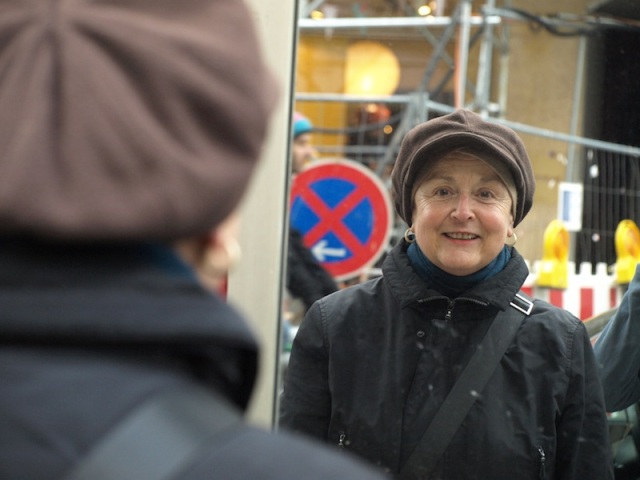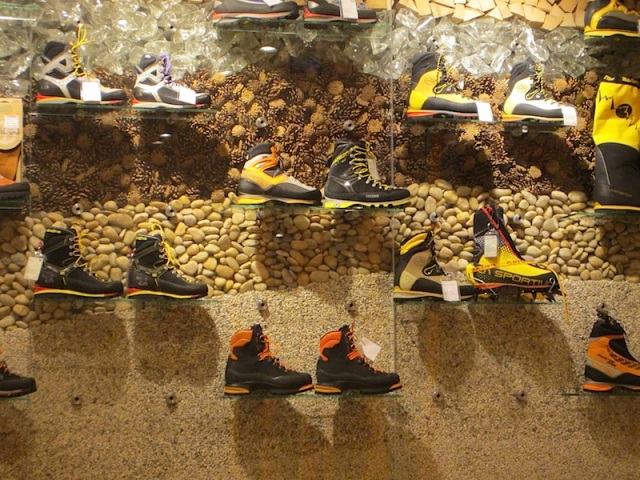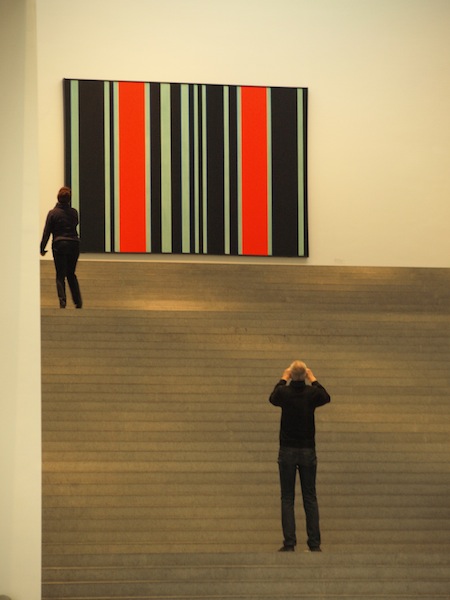SATURDAY 10TH NOVEMBER 2012.
TRIESTE TO MUNICH
The train left Trieste at 9-30am so we had time to buy some makings for lunch. We will be train bound until 5-30pm, our estimated arrival time in Munich.
I managed to do some writing on the train but as we drew closer to Verona I gave up as the scenery became more interesting.
 Last night I researched Verona and if I had done so before buying our train tickets we may have been tempted to stay there as it has an interesting past. Interesting because it was Goth country.
Last night I researched Verona and if I had done so before buying our train tickets we may have been tempted to stay there as it has an interesting past. Interesting because it was Goth country.
Goths were an East Germanic tribe who were a force to be reckoned with. They played a leading role in the fall of the Roman Empire and the emergence of Medieval Europe. In the 3rd century the Goths ravaged the Balkan Peninsula, Anatolia (Turkey) and as far as Cyprus, sacking Athens, Byzantium and Sparta at the same time. Carnage and plunder aside they did contribute one thing to our present day culture and that is polychrome design. The Goths were into contrasting colour and they not only painted buildings, but introduced colour into jewellery and ornamentation generally.

An example of a polychrome decoration. This is a reconstructed colour scheme of the entablature on a Doric temple. Image from Wikipedia.
So next time you take to painting the side of your shed in two or more colours you can thank the Goths who came up with the idea.
There’s another modern day influence relating to the Goths and that is Gothic fashion. Goth fashion is a clothing style worn by members of the Goth subculture. It is a dark, sometimes morbid, eroticized fashion and style of dress. Typical Gothic fashion includes a pale complexion with coloured hair, black lips and black clothes.
Verona has other claims to fame as well. It was the setting for two of Shakespeare’s plays, Romeo and Juliet and the Taming of the Shrew. These days the balcony on which Juliet stood is a tourist attraction. I believe it is rented out for wedding photos. I hope the newlyweds who pose for photographs have a longer life together than Romeo and Juliet did. Verona is now known as the City of Love.
According to tradition this was the house of the Capulet Family, the family of Shakespeare’s heroine. Damaged over the centuries, the house and the picturesque courtyard have been restored with a clever decorative elements inspired from the Medieval Age. Now I have found out all this I’m sorry we didn’t get off the train and stay in Verona for a couple of days.
Changed trains at Verona and were soon on our way to Munich. Bev struck up a conversation with a German man who lives in Tuscany and returns to Munich on a regular basis to present a jazz radio program. On his business card his occupation is stated as Musikjournalist-Jazz Violinist Rundfunkmoderator. Amazingly we had a lot in common, not only because of my past experiences relating to an ABC radio program I presented in the 90s but I described how my interest in classical music evolved, which interested him.
My interest in classical music began during my senior school years in the 1950s. At the time there were limited subjects to study and there was no attention to music until the second last year of my schooling. I was about 14 when a music teacher was appointed. We nicknamed the teacher Mozart and one of the very first pieces of music he played on the gramophone was the opera Madame Butterfly. I had never heard such beautiful music; my senses were awoken. Unfortunately Mozart was only with us for a couple of terms as he had a heart seizure whilst demonstrating his underwater swimming skills at one of the school swimming carnivals. He could swim underwater for two lengths of an Olympic-sized swimming pool. His death was a great loss. Had he lived I may have developed a greater interest in music that could have led to a different vocational direction.
In 1972 when Bev and I lived in an Engliah country manor (the one where I used to set the evening fires) and the owner invited musician friends to the manor every Sunday afternoon for musical recitals. The owner played the cello and his friends viola, violin and piano. We would sit at the top of the staircase and listen to the music waft up from the drawing room. The afternoon soiree further deepened our interest in classical music. Another experience we have never forgotten was an organ recital in St Stefan’s Cathedral in Vienna.
My days, as a roving reporter, (Rundfunkmoderator) were before the days of digital editing. To edit out a section of an interview you cut the tape with a razor blade and joined the wanted sections with a sticky joiner. The tape recorder I’m using in the above photograph is a Swiss made Nagra, a beautiful piece of engineering and now, after writing this story, I am inspired to start using it again. During my time as a ‘Rundfunkmoderator’ I interviewed many people from all walks of life and I still have the recordings. One day I will get them into the National Archives. So much to do and so little time to do it!
I showed Marcus some images from the blog and he particularly liked the photographs showing our kayaking adventures as we travelled down the coast of WA. An American sitting nearby came to us and said he overheard my stories and asked could he too have look, as he was a keen birdwatcher. I was so busy talking I missed most of the dramatic scenery through the Italian Alps and the Brenner Pass into Germany.
At Munich our friend Margit met us. She worked in our pottery workshop in 1988 and since then we have visited each other on a number of occasions.
Over the next few days we are staying in the apartment of a friend who is away in Chile working. Josef , in whose flat we are staying, visited us in Australia a few years ago.
MUNICH
11TH to FRIDAY 16th NOVEMBER 2012.
Last night I did my best to stay awake until midnight so I could hear Marcus (the radio presenter we met on the train yesterday) present his program. Unfortunately I wasn’t awake for the introduction but I did hear him introduce a jazz segment featuring Bix Beiderbecke. B.B. was the most influential piano and cornet jazz soloist of the 1920s. I’m telling you this because I got into a discussion with Marcus about the fact I once thought I heard Bix Beiderbecke on clarinet. Marcus insisted I was wrong and now after a little more research on my part I find Marcus was right, he only ever played the cornet and piano.
On the way into Munich by train today we saw painted on the edge of a railway platform the words ‘WORK CONSUME WORK. WORK CONSUME WORK’. I’m not sure if it is encouraging Munich residents to work harder and consume more and thus promote the economy or if it’s a tongue-in-cheek statement telling them they are working themselves to death and they should ease up a little.
It was hard to get a decent photograph of the Marienplatz today as Christmas market stalls have been set up creating some congestion. In addition, a huge Christmas tree has been set up in front of the Neue Rathaus. An interesting story relates to a local kitchen cupboard manufacturer who wages a bet with people who order a new kitchen before Christmas. If the tree has snow on it on Christmas day they get their kitchen free of charge.
The Rathaus has a glockenspiel to entertain tourists. I don’t find glockenspiels all that interesting but obviously others do.
The Marienplatz is dominated by the New Town Hall (Neue Rathaus). The monumental, 79m high town hall was built between 1867 and 1909 in Flemish Gothic style. Amazingly during WW2 it was not destroyed.
Now for a look at some of the ‘stuff’ I found in the shops.
RETAIL THERAPY.
Candle wax head sculptures on top of bottles
These heads were about two thirds full size.
Creative display model.
 I’m not sure if it was the beanie or the head that was for sale. Maybe you bought both and simply put them on the shelf as a piece of art.
I’m not sure if it was the beanie or the head that was for sale. Maybe you bought both and simply put them on the shelf as a piece of art.
Modern plastic sculptures. The elephant stood around 300mm high. The plastic shoes were not for wearing.

 Colourful paper products below. I wouldn’t have a clue why you would want a box in the shape of a letter. When I see letter boxes like this I ask myself who is designing and making all this. Are they individually handmade or is there,Not far from a million dollar machine out there knocking them out by the thousands?
Colourful paper products below. I wouldn’t have a clue why you would want a box in the shape of a letter. When I see letter boxes like this I ask myself who is designing and making all this. Are they individually handmade or is there,Not far from a million dollar machine out there knocking them out by the thousands?
The following three images are taken inside the New York based Abercrombie and Fitch clothing store. Colourful lighting and loud music was the theme of this shop. It was an amazing experience to wander through this clothing emporium. Rock music pounded away and set you in the ‘let’s get some of this gear’ mood. I pity the shop assistants who are exposed to the deep thump of the music all day.
Not far from the clothing store there was an outdoor equipment store. Near Munich there is some pretty wild country so there is the opportunity to ski, climb, walk and kayak.
Presentation and packaging is important to German shoppers. However, I can’t help but think the excessive packaging is detrimental to the environment.
People interested in buying a canoe or kayak are able to give them a test run before buying. The test pool was about one metre deep.
You need to look closely into the following two photographs. When you do it is possible to see all the things you are likely to walk over when ‘out there’.
The walls comprised plate glass about 12 mm thick and held in position with intricate stainless steel anchor bolts. The cavity between the masonry wall and the glass was filled with stones of varying size, woodchips, sea shells, pine cones, blocks of wood, chunks of glass and sand. All very creative but the cost of the wall construction is added to the price of the shoes. It’s all this advertising hype that adds to making shopping in Germany expensive.
Below is an example of advertising gone mad. Whilst pointing Percy at the porcelain you are able to watch a miniature video advertising screen.
FOOD INDULGENCE.
These little delicacies cost about $7-50 each. I can understand why, as they would take a lot of time to make. Give me a $2 rockcake any day.
Germans are good at many things but one thing they do extra well is bake bread. You never see ‘zonky’ pre-sliced packaged bread. They also know how to fill the bread. You can gorge yourself silly. German folk are fastidious about bread and like to buy it fresh every day. I read that 50% of bread baked in Germany each day is thrown away because of this desire. Bev and I never throw bread away. I call stale bread ‘waste not want not bread’. The saying came from when we were travelling in Europe in 1972 as sometimes we couldn’t get bread so we kept old bread in reserve.
There are 1300 breweries in Germany producing between 4500 and 5000 different brands. During the sixteen day Oktoberfest held in Munich each year five million litres of beer are consumed. Five million litres is equivalent to two Olympic-sized swimming pools. The statistics with regards per capita consumption varies but at the moment Germans are second on the list, consuming around 107 litres per person annually. Some German men are a little too fond of beer as it is not uncommon to see them walking around the city with a bottle of beer in hand. The more discreet have a bottle in their inside coat pocket and they whip it out and have a swig every now and then. The Czech republic tops the list, consuming 132 litres per head per year.
Australia is eighth on the list, consuming only 83 litres per head per year. Folks in Darwin however consume the most per capita of any city in Australia. They manage to down 230 litres per year. It is believed the reason Darwinites drink so much is because they can’t swim in the sea due to the nasties like crocs and stingers. So, to cool off, they drink beer.
ENGINEERING ACHIEVEMENT IS A GERMAN SPECIALITY.
When serving my apprenticeship as a toolmaker back in the late 1950s many German born toolmakers migrated to Australia. I expect they came for two reasons. There was a shortage of skilled tradesmen in Australia following WW2 and they probably wanted to start a new life outside war-torn Germany. In the tool room where I worked, German toolmakers were revered, the most difficult jobs were given to them.
German toolmakers are still knocking out quality equipment, printing presses, woodworking machinery and of course, cars. During our stay we visited the BMW World located close to the 1972 Olympic Stadium. BMW stands for Bavarian Motor Works.
Just after entering the showroom, we were approached by a salesman suggesting we consider buying a BMW. I told him I was a Toyota man and I didn’t think a BMW would be suitable for our needs. When he quizzed me as to our needs I said; no power windows, no central locking doors, no carpets, no computerised fuel injection and any of the other sophistication associated with modern cars. However even though BMWs are not my style I do appreciate the engineering perfection relating to BMW production. The following photographs show what I mean.
The above tail light image might not be all that interesting to some but one needs to look at car bodywork as a form of sculpture. If I had to nominate man’s greatest artistic achievement for the 20th century I would say metal sculpture in the form of car bodies.
Nearby the BMW World is the Munich Olympic Games site. Bev attended the games just prior to me joining her in 1972. The stadium today, although well cared for, is dated. I noticed some of the engineering aspects are typical of the 1970s. Today the towers would be a lot more refined and streamlined.

Extra heavy-duty cable anchor points. These days with high tech materials I imagine these joins would be a lot finer.
The underground in Munich is another amazing construction.
Much of the underground rail system was constructed for the 1972 Olympic Games but over the years there have been some new stations built. Below are some images of one of the newer stations. The ceiling here at Munchner Freiheit was covered with mirrors. This is modern art expressed in architecture.
All around Munich centre there are some wonderfully artistic modern buildings and one is the Museum of Modern Art. Margit’s friend, Cordela, who is a retired history teacher and now part-time tour guide took us there. The building was clad with glazed extruded clay sections.

From my experience with clay extrusions, I know making, glazing and firing these tubes without them warping is quite an achievement.
Not all modern art is found inside the museum. Following is one of my quickdraw shots, which I think is rather artistic.
Had the rigger hooked a chain on each corner of the sheets they would have bent in the middle basically rendering them useless. Also they would not have taken on this beautiful artistic form. When I look at this image I’m reminded of what Dutch artist Ben said, ‘Everything is art, art is everything. Art is just a name and a date’.
So ends Part 1 of the Munich story. Part 2 coming up soon. Apologies to all our German friends if I have a fact or two wrong.











































